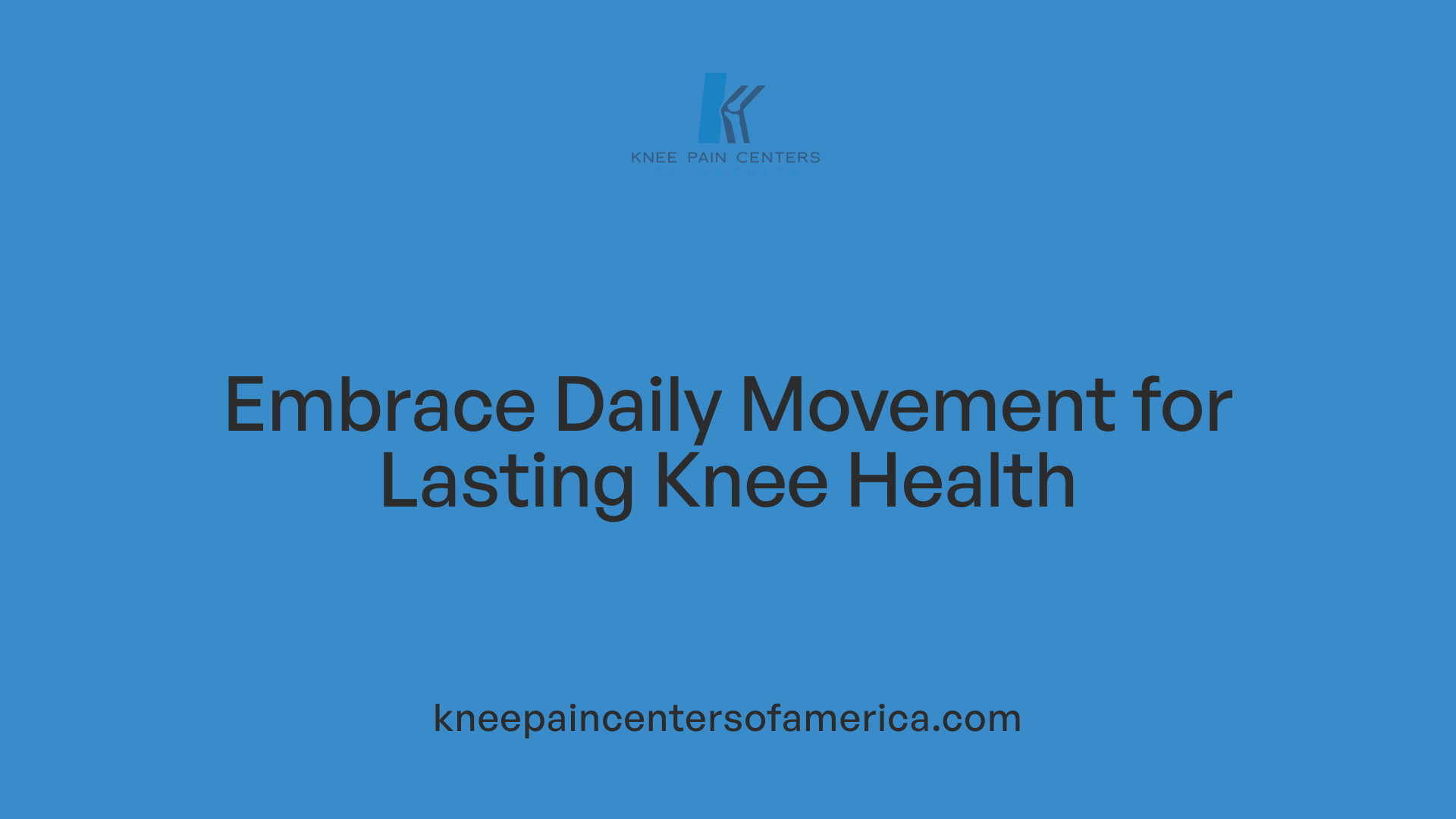Understanding Osteoarthritis and Joint Flexibility Challenges
Osteoarthritis of the knee is a common condition caused by wear-and-tear damage to the cartilage cushioning the joint, leading to symptoms such as pain, stiffness, swelling, and loss of flexibility. These symptoms impair joint function and limit mobility, affecting the quality of life. Maintaining and improving joint flexibility through targeted exercises is a crucial aspect of managing knee osteoarthritis. Movement acts as a 'lotion' for joints, helping to keep them flexible and reducing the progression of stiffness and pain. This article explores various exercises and strategies to safely enhance joint flexibility and support overall knee health in individuals diagnosed with osteoarthritis.
The Importance of Exercise for Knee Osteoarthritis

How Does Exercise Help Manage Osteoarthritis?
Exercise plays an essential role in managing knee osteoarthritis by improving joint flexibility and reducing pain. Regular physical activity encourages movement, which acts like "lotion" for stiff joints, helping to maintain and improve their range of motion. It reduces inflammation and promotes the production of synovial fluid, the lubricant in joints, which eases movement and lessens discomfort.
What Are the Benefits of Exercise on Pain, Stiffness, and Joint Function?
Exercise benefits individuals with knee osteoarthritis in several ways:
- Pain Reduction: Activities such as aerobic exercises (walking, swimming, cycling) and low-impact workouts reduce joint pain and improve function within weeks.
- Decrease in Stiffness: Stretching exercises targeting muscles like the hamstrings, quadriceps, and calves help minimize stiffness.
- Improved Joint Function: Strengthening exercises enhance muscle support around the knee, improving stability and mobility.
Together, these effects contribute to better joint health, increased circulation, and decreased fatigue.
How Does Exercise Support Tissue Healing and Muscle Strength?
Strengthening exercises, including straight leg raises, quadriceps sets, and calf raises, build muscle around the knee, supporting weakened joints and reducing stress on the cartilage. This muscle support is vital for joint stability and slows the progression of osteoarthritis.
Exercise also promotes tissue healing by increasing blood flow and facilitating nutrient delivery to the joint structures. Activities are best started gently and gradually increased, ensuring they neither exacerbate symptoms nor cause new pain.
Maintaining a tailored exercise program under professional guidance ensures safe progression, maximizing benefits while protecting joint health.
Types of Exercises to Improve Joint Flexibility and Strength
What are range-of-motion exercises and how do they help?
Range-of-motion exercises are gentle activities designed to improve joint flexibility and function. They often include movements like knee bends and stretches that aim to reduce stiffness and increase mobility. These exercises can be performed daily and help maintain or restore the natural movement of the knee, easing osteoarthritis symptoms.
Which stretching exercises target key muscle groups?
Stretching exercises focus on relaxing and lengthening muscles that support the knee joint. Important stretches include those for the hamstrings, quadriceps, calves, and hip flexors. For example:
- Hamstring stretch: Gently bending forward while keeping the leg straight helps loosen back thigh muscles.
- Quadriceps stretch: Pulling the heel toward the buttock while standing or lying down stretches the front thigh muscles.
- Calf stretches: Leaning against a wall with one leg extended back stretches the calf muscles. Holding stretches for 20-30 seconds and performing 2-3 sets daily can effectively reduce stiffness.
What strengthening exercises benefit the knee joint?
Strengthening exercises build muscle that supports and stabilizes the knee, which reduces joint stress and pain. Recommended exercises include:
- Straight leg raises
- Quadriceps sets (contracting the front thigh muscle without moving the leg)
- Half squats
- Heel raises
- Side leg raises These exercises are generally done in small, consistent repetitions throughout the day and gradually increased as strength improves, helping to protect the joint from further damage.
How do balance and functional exercises improve mobility?
Balance and functional exercises like single-leg balances and step-ups enhance joint function and stability. They improve muscle coordination and proprioception (awareness of body position), which supports safer movement and reduces the risk of falls. Activities such as yoga and Tai Chi also contribute to balance improvement and flexibility.
These varied exercise types collectively support joint health in knee osteoarthritis by improving flexibility, muscle strength, and stability, thereby reducing pain and enhancing mobility.
Low-Impact Aerobic Activities to Support Joint Health
Recommended Aerobic Exercises: Walking, Biking, Swimming, Water Aerobics
Engaging in regular low-impact aerobic activities is essential for individuals with knee osteoarthritis to maintain mobility and reduce joint pain. Walking is a simple yet effective exercise that supports muscle strength and improves blood flow without putting excessive stress on the knees. Biking, whether outdoor cycling or stationary biking, offers cardiovascular benefits and enhances flexibility and strength in muscles surrounding the knee.
Swimming and water aerobics provide the advantage of buoyancy, significantly reducing pressure on the joints while supporting muscle strengthening and joint flexibility. These activities are gentle on the knees and particularly suitable for individuals seeking effective exercise without aggravating symptoms.
Benefits of Low-Impact Cardio Activities
Low-impact aerobic exercises reduce joint stress compared to high-impact activities like running or jumping. By minimizing mechanical load, they help prevent further cartilage wear and joint pain. Additionally, these exercises stimulate the production of synovial fluid—the natural lubricant in joints—which enhances joint mobility and reduces stiffness.
Regular participation in low-impact cardio can improve circulation around the joints, decrease inflammation, and promote tissue healing. These physiological effects collectively contribute to decreased pain, improved function, and enhanced quality of life for knee osteoarthritis patients.
Indoor Exercise Options: Stationary Cycling and Elliptical Training
For those facing weather constraints or mobility challenges, indoor options like stationary cycling and elliptical training provide effective alternatives. Stationary bikes allow controlled, low-impact movement that strengthens muscles without overloading the joint.
Elliptical trainers mimic walking or running motions but with less joint impact, offering cardiovascular and muscular benefits suitable for osteoarthritis management. These machines also provide adjustable resistance settings to tailor workouts to individual capacity, making them accessible for varying fitness levels.
By incorporating these low-impact aerobic activities, individuals with knee osteoarthritis can safely enhance joint health, reduce pain, and maintain an active lifestyle.
Exercise Guidelines: Frequency, Intensity, and Progression
How should exercise duration and frequency be increased?
Gradually increasing exercise duration is important for people with knee osteoarthritis. Starting with shorter sessions and progressing to about 30 minutes per day can improve joint health and overall well-being. This gradual approach helps prevent excessive joint stress and reduces the risk of pain or injury.
What are the recommended repetitions and sets for exercises?
Exercises should begin with small, consistent efforts, such as 2-3 sets of 10-15 repetitions. Stretching exercises, for example, involve holding stretches for 20-30 seconds, performing 2-3 sets, 2-3 times daily. Over time, the number of repetitions and sets can be increased as tolerated to build strength and flexibility.
How is pain monitored during exercise?
Using a pain rating scale from 0 to 10 helps monitor discomfort. Generally, pain levels should be kept at or below 3 out of 10 during exercise. If pain increases beyond this, the intensity or duration should be reduced. This careful monitoring helps maintain safe exercise levels without exacerbating joint symptoms.
When should exercise be stopped?
Exercise should be stopped immediately if symptoms worsen or new pain develops. Persisting or intensifying pain warrants consultation with a healthcare professional to reassess and modify the exercise program.
Why is consultation with healthcare providers important?
Because each person’s condition and capacity differ, exercise programs should be tailored individually. Healthcare providers help design suitable routines, provide guidance on progression, and ensure exercises support joint recovery without causing harm. This personalized approach helps optimize benefits and minimize risks.
Following these guidelines ensures safe, effective exercise for managing knee osteoarthritis, improving pain, mobility, and quality of life.
Warm-Up and Stretching Protocols for Safe Movement
Why Warm-Up Activities Are Essential
Starting with warm-up exercises such as cycling, walking, or elliptical training prepares the joints and muscles for more intense movement. These activities gently raise the heart rate and increase blood flow, which helps relax muscles and reduce the risk of injury.
Effective Stretching Techniques
Specific stretches play a crucial role in maintaining knee joint flexibility for people with osteoarthritis. Key stretches include the hamstring stretch, quadriceps stretch, and calf raises. These exercises target muscles that support and stabilize the knee.
How to Perform Stretching Safely
To maximize benefits and prevent discomfort, each stretch should be held for 20 to 30 seconds. Repeating stretches for 2 to 3 sets, two to three times daily, helps improve muscle elasticity over time. Stretching should be done with gentle control, avoiding any bouncing or sudden movements.
Stretching's Impact on Joint Health
Regular stretching enhances the range of motion by reducing muscle stiffness around the knee. This increased flexibility lessens resistance during joint movement, contributing to lower pain levels and improved mobility. By integrating systematic stretching with warm-up routines, individuals with osteoarthritis can support joint health and maintain safer, smoother movements throughout daily activities.
Strengthening Surrounding Muscles to Improve Joint Stability
Which muscle groups support the knee in osteoarthritis management?
The knee joint is supported by several crucial muscle groups, including the quadriceps, hamstrings, calves, and hip flexors. These muscles work together to stabilize the knee, absorb shock, and assist in movement, reducing strain on the joint itself.
What strength training exercises are beneficial for people with knee osteoarthritis?
Strengthening exercises targeted at these muscles have been shown to improve joint stability and decrease knee pain. Recommended exercises include:
- Leg extensions: Practiced while sitting to strengthen the quadriceps
- Half squats: Strengthen thigh muscles without excessive joint pressure
- Heel raises: Focus on calf muscle strength
- Straight leg raises: Help build quadriceps strength without bending the knee
How can resistance bands and bodyweight exercises be used?
Incorporating resistance bands and bodyweight movements enhances these exercises by providing adjustable resistance and improving muscle endurance. Resistance bands can be used for leg extensions or side leg raises, while bodyweight exercises include squats and step-ups.
What impact does strengthening have on joint stress and function?
Strengthening surrounding muscles supports the knee by absorbing forces that would otherwise stress the joint. This reduces wear on articular cartilage, alleviates pain, and improves overall joint function. Enhanced muscle support also contributes to better balance and mobility, helping patients maintain daily activities with less discomfort.
Regular, tailored strength training is a vital part of osteoarthritis care, complementing aerobic and flexibility exercises to maintain a healthy, functional knee joint.
Balance and Functional Exercises to Enhance Mobility and Prevent Falls

What Types of Balance and Functional Exercises Are Recommended?
Balance and functional exercises specifically designed for people with knee osteoarthritis include single-leg balance, step-ups, Tai Chi, yoga, and stability ball exercises. These exercises often involve controlled movements that target joint stability and muscle coordination.
How Do These Exercises Improve Joint Function and Reduce Fall Risk?
Engaging in balance-focused activities enhances joint function by improving flexibility, posture, and muscle control around the knee. Tai Chi and yoga, in particular, contribute to better body awareness and alignment, which lowers the risk of falls. Stability exercises help strengthen the muscles supporting the knee, contributing to overall joint stability.
What Are the Broader Benefits for Joint Health and Confidence?
Regular practice of these exercises supports overall joint health by increasing flexibility and reducing stiffness. Improved balance and functional ability foster confidence in daily movements, enabling people with osteoarthritis to maintain independence and reduce fear of injury. Incorporating these activities can complement other aerobic and strengthening exercises for a comprehensive knee health management plan.
Managing Pain and Inflammation During Exercise
Monitoring pain levels and adjusting exercise intensity
It is crucial for individuals with knee osteoarthritis to regularly monitor their pain while exercising. Using a pain rating scale from 0 to 5 out of 10 helps guide safe levels of activity. Patients are advised to maintain their pain within a tolerable range and reduce intensity if the pain worsens beyond this threshold.
Using pain rating scales (0-5 out of 10) for safe exercise
The pain rating scale allows patients to quantify their discomfort during or after exercise. Staying at a pain level of 0 to 3 out of 5 ensures exercises remain beneficial without causing harm. If pain rises above this, modifications like decreasing repetitions or switching to less stressful activities are recommended.
Pain management strategies including medication and rest
In addition to adjusting exercises, pain management may include the use of prescribed medications to control inflammation and discomfort. Rest periods during and after exercise sessions help the joint recover and prevent overuse injuries.
Importance of avoiding exercises that cause new or worsening symptoms
Exercise routines should exclude any movements that produce new pain or exacerbate existing joint symptoms. If symptoms persist or worsen, it is important to consult a healthcare professional for tailored advice and potential treatment adjustments.
Applying heat before and ice after exercise to manage discomfort
Applying heat prior to exercising helps relax muscles and increase joint flexibility, reducing stiffness. After completing exercises, icing the affected knee can diminish swelling and relieve pain, aiding in recovery and inflammation control.
Lifestyle Integration and Long-Term Benefits of Regular Exercise

How can daily activities be incorporated into exercise routines?
Incorporating simple, everyday activities like walking the dog, mowing the lawn, or gardening provides beneficial movement without needing a formal workout. These activities count towards maintaining joint function and contribute to overall mobility by keeping muscles active and joints flexible.
Why is maintaining a healthy weight important for knee osteoarthritis?
Maintaining a healthy weight is crucial because excess body weight significantly increases pressure on the knee joints; every 3 pounds of extra weight can add about 10 pounds of stress. Weight management through exercise reduces this strain, alleviating pain and preventing further joint damage.
How does regular movement improve joint health?
Regular exercise improves blood circulation, which helps nourish the joint tissues and remove waste products. Physical activity also stimulates the production of endorphins, the body’s natural painkillers, thereby reducing arthritis-related pain and enhancing overall well-being.
What is the recommended exercise intensity progression for arthritis patients?
A gradual increase in exercise intensity is recommended, starting with low-impact activities and progressing to moderate levels. About 30 minutes of moderate daily exercise can improve joint health, reduce stiffness, and enhance mobility without causing additional joint stress.
How do exercises fit into comprehensive osteoarthritis management?
Exercise is a cornerstone of osteoarthritis management—it helps strengthen muscles supporting the knee, improves flexibility, reduces pain, and aids in maintaining joint function. Alongside medication and lifestyle modifications, consistent physical activity promotes long-term joint health and improves quality of life for those with knee osteoarthritis.
Summary and Encouragement for Active Osteoarthritis Management
Exercise is a cornerstone in managing knee osteoarthritis, offering significant benefits in improving joint flexibility, reducing pain, and enhancing overall mobility. A balanced program combining range-of-motion stretches, muscle strengthening, low-impact aerobic activities, and balance exercises tailored to individual abilities helps support joint health safely and effectively. It is essential to monitor pain, progress gradually, and seek professional guidance to optimize outcomes and avoid injury. By embracing consistent, adapted physical activity, individuals with osteoarthritis can maintain independence, improve quality of life, and slow the progression of joint stiffness and discomfort.
References
- Exercises for Knee Osteoarthritis and Joint Pain
- Exercises to help with osteoarthritis of the knee
- Best Exercises for Osteoarthritis (OA) of the Knee
- Exercising with arthritis: Improve your joint pain and stiffness
- Simple Exercises for Knee Arthritis | FVS
- 10 Visuals of Exercises to Help Relieve Knee Pain
- These Exercises Are Best for Knee Pain, Research Finds





